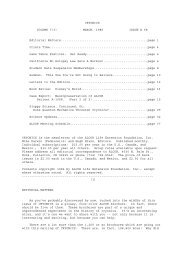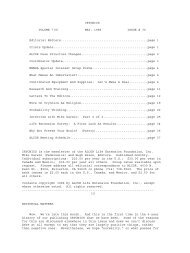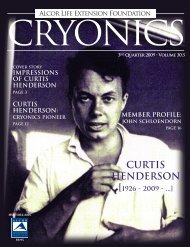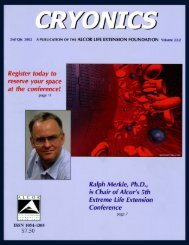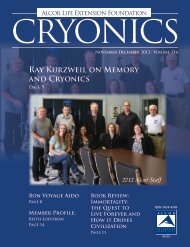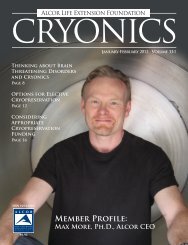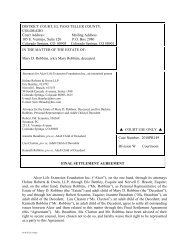Robert Ettinger - Alcor Life Extension Foundation
Robert Ettinger - Alcor Life Extension Foundation
Robert Ettinger - Alcor Life Extension Foundation
You also want an ePaper? Increase the reach of your titles
YUMPU automatically turns print PDFs into web optimized ePapers that Google loves.
Appendix 1: What are <strong>Alcor</strong>’s<br />
Costs for a Cryonics Case?<br />
In 2011, <strong>Alcor</strong>’s cryopreservation<br />
funding minimums are $80,000 for neuropreservation<br />
and $200,000 for whole body<br />
cryopreservation. These amounts are composed<br />
of:<br />
Neuropreservation<br />
$25,000 to the Comprehensive Member<br />
Standby (CMS) Fund<br />
$30,000 to <strong>Alcor</strong> Operations for<br />
cryoprotection and deep cooling<br />
$25,000 to the Patient Care Trust<br />
Whole Body Cryopreservation<br />
$30,000 to the Comprehensive Member<br />
Standby (CMS) Fund<br />
$60,000 to <strong>Alcor</strong> Operations for<br />
cryoprotection and deep cooling<br />
$110,000 to the Patient Care Trust<br />
The CMS Fund<br />
The Comprehensive Member Standby<br />
Fund is a segregated account that <strong>Alcor</strong><br />
maintains for the purpose of paying for everything<br />
<strong>Alcor</strong> does to respond to cryonics<br />
cases outside of the <strong>Alcor</strong> facility. It includes<br />
a readiness component, which pays staff<br />
salaries in proportion to the amount of time<br />
staff members spend on field work and field<br />
work readiness. It also pays the marginal<br />
costs of case field work, including transportation,<br />
lodging, consumables, and bills when<br />
contractors, such as Suspended Animation,<br />
Inc. (SA), are used for case field work. CMS<br />
is funded by an annual $180 charge to <strong>Alcor</strong><br />
members, and by $25K and $30K amounts<br />
drawn from case funding for neuropreservation<br />
and whole body cases respectively.<br />
The case funding contributions to CMS are<br />
considerably less than the actual costs of a<br />
full remote case response, with the shortfall<br />
made up by less expensive local cases and<br />
cases for which there is no advance notice<br />
before legal death.<br />
CMS income and expenses are tracked<br />
separately from <strong>Alcor</strong>’s general funds, allowing<br />
<strong>Alcor</strong> to keep close track of whether<br />
CMS charges are keeping up with the<br />
costs of cryonics case field work.<br />
<strong>Alcor</strong> Operations<br />
Costs of in-facility work on cryonics<br />
cases, comprising cryoprotective perfusion,<br />
deep cooling, and placement in long-term<br />
care, are paid for from <strong>Alcor</strong> general funds.<br />
They are the only part of cryopreservation<br />
costs that presently don’t have a separate<br />
account. Detailed costs for this part of<br />
cryonics include the cost of contract surgeons,<br />
consumables, ingredients for cryoprotective<br />
perfusate (which can reach $20K<br />
for whole body cases), liquid nitrogen for<br />
deep cooling, and depreciation of all the<br />
necessary capital equipment. Staff costs<br />
also need to be paid.<br />
Gains or losses in this part of cryonics<br />
procedures affect <strong>Alcor</strong>’s general operating<br />
budget. In 2010 <strong>Alcor</strong> began charging a<br />
$50K indirect costs charge to cryonics case<br />
funding to help balance the general operating<br />
budget. This amount is only drawn<br />
from case funding after the above-described<br />
allocations, including PCT amount,<br />
have been paid, and only if case funding is<br />
sufficient to pay it. Remaining cryopreservation<br />
funding, if any, is distributed according<br />
to Attachment 1 of the member’s<br />
Cryopreservation Agreement.<br />
The Patient Care Trust<br />
The Patient Care Trust (PCT) is a legally<br />
separate trust with its own Board of<br />
Directors that is charged with maintaining<br />
and disbursing funds to maintain longterm<br />
care of <strong>Alcor</strong> patients at cryogenic<br />
temperature. At the end of August 2011,<br />
the PCT held assets conservatively valued<br />
at $7,000,000 and disbursed approximately<br />
$170,000 a year to <strong>Alcor</strong> to pay expenses<br />
associated with the maintenance of 107<br />
patients (71 neuro, 36 whole body). Those<br />
expenses were approximately composed of:<br />
$50,000 Liquid Nitrogen<br />
$50,000 Labor (<strong>Alcor</strong> staff cost billed to<br />
PCT)<br />
$35,000 Rent*, Utilities, Insurance<br />
$30,000 Depreciation (dewars and infrastructure)<br />
$5,000 Miscellaneous<br />
*Although the PCT owns the company<br />
that owns <strong>Alcor</strong>’s building, <strong>Alcor</strong> leases<br />
space from that company and is reim-<br />
bursed by the PCT for the portion of the<br />
building it rents for patient care.<br />
These expenses imply a marginal cost<br />
of at least $10,000 per year for each new<br />
storage dewar brought into service, excluding<br />
labor. The dewars used by <strong>Alcor</strong> hold<br />
either four whole body patients plus five<br />
neuropatients, or 45 neuropatients. The annual<br />
marginal cost of maintaining a whole<br />
body patient is therefore minimally $10,000<br />
/ 4.5 = $2200 per year in 2011, or $220 per<br />
neuropatient.<br />
<strong>Alcor</strong> attempts to set the PCT portion<br />
of cryopreservation minimums so that<br />
marginal costs of patient care can be met<br />
by only a 2% annual draw on principal*.<br />
This is to ensure long-term real growth<br />
of principal to survive difficult economic<br />
times and eventually fund revival and reintegration.<br />
This criterion minimally implies<br />
a required PCT principal of $110,000 per<br />
whole body patient and $11,000 per neuropatient.<br />
In 2011 the actual PCT allocations<br />
of the cryopreservation minimums<br />
of whole body patients and neuropatients<br />
were $110,000 and $25,000 respectively.<br />
There is an item related to the PCT on<br />
<strong>Alcor</strong>’s balance sheet called the Deferred<br />
Patient Care Reserve. It is computed as<br />
(number of neuropatients) * (current neuropatient<br />
PCT allocation) + (number of<br />
whole body patients) * (current whole body<br />
patient PCT allocation). It is intended to be<br />
an estimate of the PCT principal required<br />
to sustain <strong>Alcor</strong>’s current patient population.<br />
It is recorded as a liability, recognizing that<br />
responsibility for providing patient care is an<br />
obligation. The remaining PCT equity, $1.5<br />
million in August, 2011, is theoretical excess<br />
funding that may be able to grow to fund<br />
future revival and reintegration (R&R).<br />
*The 2% annual draw criterion was<br />
first articulated in the seminal 1990 article,<br />
The Cost of Cryonics. (The article actually<br />
imposed an additional safety factor of two,<br />
concluding that principal equal to 100 times<br />
the annual cost of care should be required.)<br />
After abandoning explicit draw criteria for<br />
many years, <strong>Alcor</strong> is attempting to return to<br />
a 2% criterion.<br />
............................................................................<br />
www.alcor.org Cryonics/Fourth Quarter 2011 13



